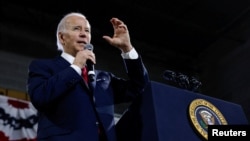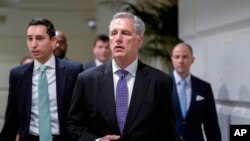President Joe Biden met with House Speaker Kevin McCarthy at the White House Wednesday afternoon, the first in-person sit-down between the two leaders since Republicans assumed control of the House of Representatives following the November midterm elections.
The pair discussed a range of issues, including the urgent need to raise the nation’s debt ceiling, the amount of money authorized by Congress for the government to borrow to meet existing spending obligations.
Biden made clear to McCarthy that “it is their shared duty not to allow an unprecedented and economically catastrophic default,” according to a statement released by the White House after the meeting. “The United States Constitution is explicit about this obligation, and the American people expect Congress to meet it in the same way all of his predecessors have. It is not negotiable or conditional.”
The U.S. hit the $31.4 trillion ceiling on January 19. Without an agreement, the country would for the first time go into default within a few months, potentially plunging the economy into a crisis.
Expectations of a breakthrough in the Biden-McCarthy session were low. Observers noted that because this was their first meeting, neither side had an incentive to look weak by arriving at a compromise too quickly.
McCarthy put an optimistic spin on the meeting.
"I told the president I would like to see if we can come to an agreement long before the deadline, and we can start working on other things,” he told reporters at the conclusion of the meeting. “I believe if we're able to get to an agreement, we could have a funding agreement for the next two years.”
The White House has drawn a hard line on negotiations, maintaining that debt ceilings should be lifted without conditions.
Lifting the debt ceiling is a “constitutional obligation” for Congress, White House press secretary Karine Jean-Pierre said during her briefing Wednesday, reiterating that the ceiling has been raised 78 times since 1960, including 49 times under Republican presidents and 29 times under Democratic presidents.
In a memo released earlier this week, National Economic Council Director Brian Deese and Office of Management and Budget Director Shalanda Young said that in the meeting with McCarthy, Biden would “seek a clear commitment” that defaulting on the nation’s debt was off the table. They called on Republicans to present a detailed budget proposal specifying the spending cuts they were targeting.
McCarthy and House Republicans say they are aiming to slash "wasteful spending in Washington" as part of a deal to raise the debt ceiling but have not formally identified the programs they want cut. Republicans broadly say they are aiming to slash domestic programs and reduce some military spending while avoiding cuts to two social programs that voters from both sides of the aisle want protected: Medicare, the health insurance program for seniors, and Social Security, which provides payments to retirees and the disabled.
Under pressure
McCarthy is under pressure from members of the ultraconservative Republican Freedom Caucus who want to drastically limit the size, scope and reach of the federal government and budget, and reform Congress to make it easier to do so. Twenty lawmakers, most of whom are members of the caucus, withheld their votes for McCarthy’s speakership through most or all of 15 ballot rounds earlier in January until he pledged to fulfill their procedural and policy demands, including enabling just one member to call for a vote seeking his ouster.
There’s “almost no evidence” that McCarthy can control the Freedom Caucus, said Ruth Bloch Rubin, who teaches American politics at the University of Chicago. However, with 222 Republicans and 212 Democrats in the House, a bipartisan coalition to achieve the 218 votes needed to lift the debt ceiling is possible with just a handful of Republicans.
“Judging from the speakership fight, [McCarthy’s] grip on the party is tenuous — but maybe not with the members most sympathetic to a bipartisan compromise,” Rubin told VOA.
McCarthy insisted Republicans are “very united.”
"Our debt is too high. We have waste in our government. And we need to sit down together in a responsible way to put us on a path to balance, and at the same time, not put any of our debt in jeopardy,” he said.
For many in Washington, the debt brinkmanship feels familiar. Republicans in Congress voted against increasing the ceiling under Democratic President Barack Obama in 2011 and 2013 but raised it three times under Republican President Donald Trump.
The government is expected to be able to keep operating until at least early June, but it’s not clear how long the Treasury Department can avoid defaulting on the debt. So, while it’s not time to panic on the debt limit yet, it is time for both parties to get serious and get to work, said Rachel Snyderman, senior associate director of business and economic policy for the Bipartisan Policy Center.
“In a time of economic change and uncertainty, the last thing hardworking Americans need is political brinksmanship jeopardizing the full faith and credit of the United States,” she told VOA.
A default could also lead to a global economic crisis, as many companies and foreign governments hold their capital reserves in U.S. Treasury notes. In 2011, the threat of default led to the downgrading of the U.S. government’s credit worthiness and to major stock market crashes around the world.

